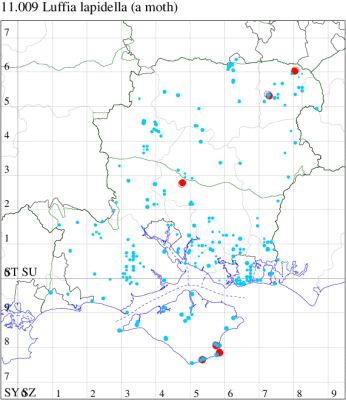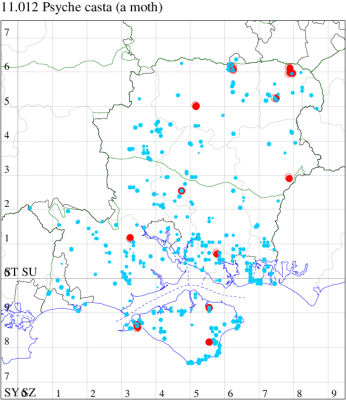2020 Annual Report for: Psychidae / Psychinae
For species seen in 2020 that had less than or equal to 100 records, full details are included; for more common species, the earliest, latest and highest count by vice-county are shown. The narrative for each species is taken from the main Hantsmoths website, and it is possible that some information on abundance and occurrence can get out of date, as it is impossible to keep up with all changes; however it should give a good introduction to each species. The tables in each species account summarise the previous status, and that for the current year.
For the maps, all records prior to 2020 are shown by a blue dot (the larger the dot, the more recent), with the current year's records shown in red. As previous records are superimposed on any report for 2020, new sites have greater emphasis (i.e. will show as 'more red').
In the species accounts, an asterisk next to a location indicates a new 10km square record; earliest ever dates are highlighted in orange, and latest ever in red. Initials in the species accounts refer to the recorders listed here. Please get in touch if you identify any omissions or errors, in particular if you have records that have yet to be submitted. Details of how to submit records can be found here.
11.009 [B&F: 0185] Luffia lapidella (=ferchaultella) (Goeze, 1783) - Common
Common in damp shady places throughout England and Wales, more numerous in the south. Fairly widely distributed across Hampshire and the Isle of Wight. The species previously considered to be common in Britain Luffia ferchaultella has recently been synonymised with L. lapidella (a species previously thought to be confined to Cornwall), and is considered a parthenogenetic form of the present taxon, L. lapidella f. ferchaultella, and while the winged males do occur in Britain, they are very rare (females are wingless); reproduction therefore is generally through parthenogenesis. Larva feeds on lichens growing on tree trunks and fence posts, living within a movable case; larval cases can be found commonly, even abundantly, on tree-trunks, fences and old walls throughout; case length 5-7 mm.
Records prior to 2020
| Vice County | #Records | #Individuals | First Record | Last Record |
|---|---|---|---|---|
| 10 | 30 | 437 | 1893 | 2019 |
| 11 | 285 | 285 | 1973 | 2018 |
| 12 | 87 | 206 | 1981 | 2019 |
2020 records
| Vice County | #Records | #Individuals | Max Quantity |
|---|---|---|---|
| 10 | 3 | 12 | 10 |
| 11 | 3 | 3 | 2 |
| 12 | 4 | 4 | 3 |

Records by year
Records by week (adult)
Records by week (larval)
Record Details
VC10: St Lawrence: Woolverton Road, case, 10, field observation, 30 Sep (PBa); Bonchurch Landslip, larva, one, field observation, 03 Feb; Shanklin, larva, one, field observation, 26 Oct (IOu);
VC11: Chandlers Ford, present, field observation, numerous cases on wooden gazebo during month of April. , 01 Apr (BE); Winchester, larval tube, two, field observation, 18 Jun (THW); Bishop's Waltham, case, one, field observation, 18 May (DTr);
VC12: Bartley Heath, present, field observation, 20 Dec; Yateley*, larva, three, 02 May; one, 03 May (JHH)
11.012 [B&F: 0186] Psyche casta (Pallas, 1767) - Common
Common throughout the British Isles, less numerous in the north. Widespread and common in Hampshire and on the Isle of Wight. Wingspan male 11-15 mm, female wingless. The distinctive case of the larva is often easily found attached to leaves and tree trunks, while the winged male is very infrequently observed, but will occasionally come to light; male dull brown, female wingless and grub-like, generally smaller than the much scarcer P. crassiorella. Larva feeds on various grasses, dead leaves, various lichens and decaying vegetable matter, living within a movable case; case length 8-12 mm.
Records prior to 2020
| Vice County | #Records | #Individuals | First Record | Last Record |
|---|---|---|---|---|
| 10 | 95 | 96 | 1856 | 2019 |
| 11 | 476 | 484 | 1973 | 2019 |
| 12 | 133 | 131 | 1975 | 2019 |
2020 records
| Vice County | #Records | #Individuals | Max Quantity |
|---|---|---|---|
| 10 | 5 | 10 | 4 |
| 11 | 3 | 4 | 3 |
| 12 | 18 | 17 | 1 |

Records by year
Records by week (adult)
Records by week (larval)
Record Details
VC10: Freshwater Cliffs, larva, four, field observation, larvae with cases, 02 Jul (SDa); Afton Marsh, larva, two, field observation, 11 Jul; Shanklin, case, one, field observation, 11 Apr; larva, two, field observation, 01 May; Firestone Copse, larva, one, field observation, 14 Jun (IOu);
VC11: Woodlands, New Forest, present, 03 Jun (RBW); Twyford, case, one, field observation, 20 May (RJD); Fareham, three, ♂s, 08 Jun (KJW);
VC12: Stockbridge Down NT, larva, one, field observation, larval case found, 23 Jul; larva, one, field observation, larval case found, 23 Jul (MDu det. PEH); Overton Lagoons*, case, one, field observation, 26 May; larva, one, field observation, 03 Jun; Overton*, case, one, field observation, 23 May (PEH); Pamber Forest, one, 23 Jun (GJD); larva, one, field observation, 08 May (DKel); Liss Forest, pupa, one, field observation, 25 Apr; pupa, one, field observation, 06 May (RJM); Odiham Common, larva, one, netted, 24 May; Castle Bottom NNR, larva, one, field observation, 24 Apr; larva, present, field observation, 15 May; Up Green Wood, Eversley*, larva, one, field observation, 07 May (JHH)
(larvae on parent case)().jpg)